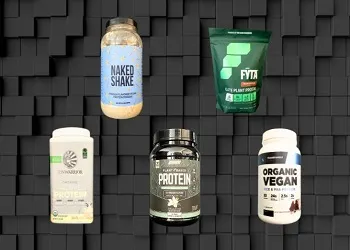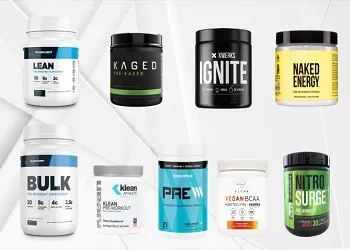Welcome to the fascinating, microscopic world of amino acids, the architects behind the protein structures in your body.
This article will discuss branched-chain amino acids (BCAAs) and essential amino acids (EAAs).
Both supplements stimulate muscle growth and accelerate recovery, but when choosing between these two powerhouses, which one should you use in your fitness plan?
After you find out the difference, we created a list of our favorite EAA and BCAA supplements.
Table of Contents
Short Summary
- If your main goal is muscle growth, you may as well use an EAA supplement or a whey protein powder over a BCAA supplement.
- BCAAs are a subset of EAAs, which include leucine, isoleucine, and valine. Leucine initiates muscle protein synthesis (MPS).
- Animal-based proteins provide an excellent source of both BCAAs & EAAs. Those following plant-based diets may want to supplement certain essential amino acids.
Understanding Amino Acids: BCAAs and EAAs
Amino acids are the building blocks of proteins that help our bodies create new cells and tissues, andcarry out physiological processes. Out of the 20 amino acids, there are nine essential ones that the body doesn’t produce.
We must consume EAAs through food or supplementation. BCAAs include leucine, isoleucine, and valine, which have a particular “branched” shape, unlike the other EAAs.
Branched-Chain Amino Acids (BCAAs)
Leucine is an especially crucial amino acid when it comes to muscular development or repair since it is the main precursor to muscle protein synthesis (MPS).
Put simply, MPS is the process in which new muscles are built from amino acids. In this way, BCAAs help increase protein production to build stronger tissues in our bodies, providing multiple benefits for healthier musculoskeletal systems and overall well-being.
Essential Amino Acids (EAAs)
Amino acids come in two varieties: those that our bodies can make and the special nine essential amino acids (EAAs which it cannot).
These important molecules have numerous jobs, such as creating proteins, aiding digestion, and providing energy, as well as repairing body tissue. Sources of EAAs are widely available in both plant and animal-based foods. However, they tend to be more abundant in meat, dairy products, and eggs.
Muscle Protein Synthesis and Recovery
Protein synthesis needs to occur to attain the benefits of muscle growth and repair,. This process includes a full team of essential and nonessential amino acids to stimulate muscle protein synthesis. Leucine in particular is known for its contribution towards stimulating the production of myofibrillar proteins, fundamental components required by muscles during recovery times.
EAAs and Muscle Growth
Essential amino acids (EAAs) are vital for comprehensive muscle growth and healing that encompass BCAAs that will help stimulate protein synthesis in order to expand muscle tissue.
EAAS also aid in keeping lean muscles intact while promoting deep sleep quality, which supports recovery processes better. They offer a more well-rounded approach when it comes to building up your body’s muscles and improving performance outcomes, too.
BCAAs and Muscle Recovery
In your pursuit of muscular augmentation and restoration (a fancy way to say growing your muscles), BCAAs could be a great help. Leucine specifically can set off the construction of muscle tissue through protein synthesis, which makes it very beneficial in this case.
There is a small amount of research that indicates that BCAAs may be beneficial in reducing delayed onset muscle soreness (DOMS), therefore minimizing recovery time.
The Debate: BCAAs vs. EAAs
When it comes to fitness, there has been a disagreement about which is the better option, BCAAs or EAAs.
On one hand, BCAAs are an inexpensive way of decreasing muscle fatigue and soreness, leading to a faster post-workout recovery time.
But for those seeking maximum performance from their exercise routine as well as muscle growth, they may find more benefit in using EAAs. This is due to them containing all nine essential amino acids necessary for full optimization compared with only three found in BCAAs alone.
Advantages of BCAAs
As mentioned above, BCAAs– and particularly leucine– have been credited for their capacity to activate muscle protein synthesis and foster muscle growth as well as restore tired muscles post-exercise.
It should be noted that while BCAAs are useful in aiding with building muscles faster, as they help reduce aches experienced after working out, compared to EAAs, they may not quite stimulate the same amount of muscle protein production. Here are some examples of the best bcaa’s out there on the market right now.
Advantages of EAAs
EAAs offer a more complete approach to help build muscles. They contain all the amino acids required for muscle protein synthesis, and they are capable of stimulating it, too, thereby enhancing muscle growth.
These EAAs also have an effect on preserving lean body mass as well as facilitating quality sleep and recovery post-workout.
In summary, these essential amino acids make sure that protein production is optimized for muscular development, making it a more comprehensive system than taking BCAAs alone.
Supplementation Strategies
It is essential to know the best time for taking BCAAs and EAAs in order to get optimum results. Both of these substances should be taken before, during, or after intense exercise, depending on one’s specific goals and requirements.
It may only sometimes stay within this framework, as individuals have their own preferences regarding supplementation timing. Furthermore, it’s much more important to focus on getting an adequate amount of amino acids every day as opposed to worrying too much about timing.
When to Take BCAAs
During or after workouts, consuming BCAAs can help reduce muscle soreness and support muscular growth. This is because they provide essential building blocks that facilitate muscle repair.
Having a pre-workout supplement containing BCAAs prior to exercise might be beneficial for long-term recovery from physical activity as it helps combat any potential musculature issues associated with strenuous activity while also helping improve overall performance.
When to Take EAAs
EAAs can be taken at any point during a workout routine – before, during or after, as well as consumed between meals. Taking the amino acids before exercising helps provide your body with all the necessary components for muscle protein synthesis. After-workout ingestion of EAAs also aids in recovery and contributes positively to muscle protein synthesis.
Diet Considerations
A balanced diet including high-protein foods such as meat, fish, dairy, and whey products is important in providing the required BCAAs and EAAs.
For individuals who follow a plant-based diet, it’s more difficult to consume enough complete proteins. However, it is not impossible. It just requires more thought and planning.
Solid nutrition should always be considered the first line of defense, but amino acid supplementation is always a good backup option for vegans and vegetarians.
Protein-Rich Foods
A balanced diet that includes high-protein foods, such as lean meats, eggs, dairy products, beans, and lentils, to name a few, can supply the body with ample amounts of BCAAs and EAAs. Animal-sourced proteins are an especially great source for both these essential nutrients making supplementation unnecessary.
Plant-Based Diets and Amino Acid Intake
Those on a plant-based diet must pay closer attention to their amino acid consumption to include all essential and conditionally essential types. Legumes, nuts, seeds, and grains can provide these molecules but may lack (or have low levels of) one or two of the essential nine. This necessitates either better dietary balance or supplementing with BCAAs (branched-chain amino acids) or EAAs (essential amino acids).
Summary
BCAAs (branched-chain amino acids) and EAAs (essential amino acids) benefit muscle growth and recovery. Taking all nine EAAs provides a more comprehensive solution than taking just BCAAs alone. It is important that your diet is balanced for supplementation to yield optimal results tailored specifically toward your own individual goals.
Frequently Asked Questions
Is amino acid and BCAA the same?
BCAA (Branch Chain Amino Acid) comprises three essential amino acids: leucine, valine, and isoleucine. These have hydrocarbon side chains that look like a branch, distinguishing them from the other essential amino acids in this respect.
Is there anything better than BCAA?
Considering BCAA supplements only provde three of the essential amino acids, a whey protein supplement or an EAA supplement will provide more comprehensive benefits, especially as it relates to promoting protein synthesis for musle repair and growth.
What are the roles of BCAAs and EAAs in muscle protein synthesis and recovery?
Amino acids are crucial to muscle growth, repair, and protein synthesis. Leucine is the BCAA that initiates muscle protein synthesis, but you need all amino acids, both essential and nonessential, to actually synthesize a muscle.
BCAAs are more often used to reduce post-exercise fatigue and soreness.
What are the benefits of BCAAs?
BCAAs are often a must-have supplement for athletes and fitness enthusiasts due to their positive effects on performance and muscle growth. They can also provide relief from fatigue after workouts as well as reduce any post-exercise soreness or discomfort. However, EAAs offer a more well-rounded approach with the same benefits.
References
Church, D. D., Hirsch, K. R., Park, S., Kim, I.-Y., Gwin, J. A., Pasiakos, S. M., Wolfe, R. R., & Ferrando, A. A. (2020). Essential Amino Acids and Protein Synthesis: Insights into Maximizing the Muscle and Whole-Body Response to Feeding. Nutrients, 12(12), 3717. https://doi.org/10.3390/nu12123717
Duan, Y., Li, F., Li, Y., Tang, Y., Kong, X., Feng, Z., Anthony, T. G., Watford, M., Hou, Y., Wu, G., & Yin, Y. (2016). The role of leucine and its metabolites in protein and energy metabolism. Amino Acids, 48(1), 41–51. https://doi.org/10.1007/s00726-015-2067-1
Is Branched-Chain Amino Acids Supplementation an Efficient Nutritional Strategy to Alleviate Skeletal Muscle Damage? A Systematic Review. (2017). Nutrients, 9(10), 1047. https://doi.org/10.3390/nu9101047
van Vliet, S., Beals, J., Martinez, I., Skinner, S., & Burd, N. (2018). Achieving Optimal Post-Exercise Muscle Protein Remodeling in Physically Active Adults through Whole Food Consumption. Nutrients, 10(2), 224. https://doi.org/10.3390/nu10020224
Witard, O., Wardle, S., Macnaughton, L., Hodgson, A., & Tipton, K. (2016). Protein Considerations for Optimising Skeletal Muscle Mass in Healthy Young and Older Adults. Nutrients, 8(4), 181. https://doi.org/10.3390/nu8040181














